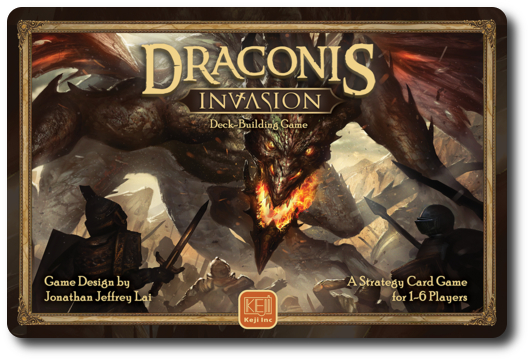
The Basics:
- For ages 10 and up (publisher suggests 14+)
- For 1 to 6 players
- Approximately 45 minutes to complete
Geek Skills:
- Active Listening & Communication
- Counting & Math
- Logical & Critical Decision Making
- Reading
- Strategy & Tactics
- Cooperative & Team Play
- Hand/Resource Management
Learning Curve:
- Child – Moderate
- Adult -Easy
Theme & Narrative:
- Defeat the army of Draconis!
Endorsements:
- Gamer Geek mixed!
- Parent Geek mixed!
- Child Geek mixed!
Overview
An evil is spreading and your kingdom is in danger! Ride out and do battle with sword and shield, but do not go alone. Wisely build your army and control your resources. Victory will go to the warrior with the most strength and the wits to properly know how to use it. But be warned. The longer the evil goes unchecked, the harder it will be to suppress the rising terror that is strangling the land.
Draconis: Invasion, designed by Jeff Lai and published by KEJI Inc., is comprised of 108 Gold cards, 90 Action cards, 114 Defender cards, 26 Randomizer cards, 16 Blue Invader cards, 17 Gold Invader cards, 24 Event cards, 1 Retreat card, 36 Terror cards, 1 Terror die, 28 Campaign cards, 48 Separator cards, and 6 Turn Overview cards. The cards are as thick and as durable as your standard playing card. The artwork by artists Juan Pablo Fernández, Vuk Kostic, Manthos Lappas, Grzegorz Pedrycz, and Unrealsmoker is excellent. The illustrations help the player easily imagine the dark fantasy world the game is set in.
Game Set Up
To set up the game, first organize the Gold cards by type (Treasure, Fortune, and Wealth), placing the cards face-up in a row. Next to this row place the Terror cards in a single deck.
Second, place the default Defender and default Action cards face-up into different piles and in a row.
Third, set up the battle stage by first determining which cards to use. The game comes with suggestions on what cards to use, but these can be randomized if the players like.
Fourth, shuffle the Blue Invader and Gold Invader cards, placing both decks face-down. Reveal the first three cards of each deck, placing them face-up in a row next to their respective draw deck.
Fifth, shuffle the Campaign cards and place the deck face-down. Reveal the first three cards and place them face-up next to the Campaign draw deck in a row.
Sixth, shuffle the Event cards and place the deck face-down. Place the Retreat card underneath the Event draw deck. Depending on the number of players in the game, draw a specific number of Event cards and place them face-up next to the Event draw deck.
Seventh, place the Terror die to one side of the game playing area and give each player 7 Wealth and 5 “Imperial Guard” Defender cards. Have each player shuffle their cards and place them face-down in front of them to create their own draw deck. Each player now draws 6 cards to create their first hand of cards.
Seventh, shuffle the Campaign cards and deal 2 to each player. Campaign cards are kept face-down but may be looked at by their owner at anytime. Place the Campaign draw deck face-down and to one side of the other cards on the table.
Eighth, roll the Terror die to determine the initial terror level. Discard cards as needed.
That’s it for game set up. Place any cards not used back in the game box and determine the first player.
A Quick Tour of a Very Dark Realm
Draconis: Invasion is a deck-building game. All the cards have a specific role to play, either aiding the player or hindering them. The different card types are summarized here.
Gold Cards
Gold cards are used to purchase other cards and to pay for use of cards. Gold cards have two different values. The first is the value to buy the card (acquiring it for later use) and the second is the amount of gold the card provides when played.

Terror Cards
Terror cards are, thematically speaking, a growing fear that lurks in the heart of men. Players gain Terror cards throughout the game and go into the player’s deck. They provide no benefit, but they can be removed. However, if the player discards their Terror cards, they cause the overall terror threat level to rise! This forces the players to consider the pros and cons of having a deck full of cards that are not useful or discarding them which makes the game all the more difficult.
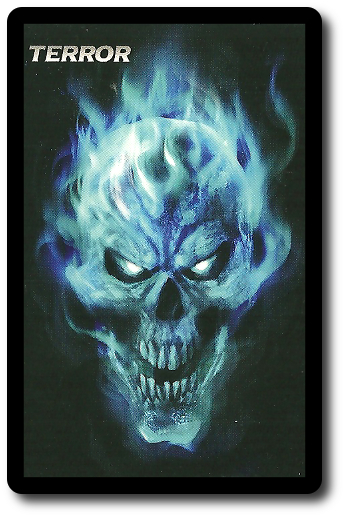
Event Cards
When the terror level rises to its highest level (“level 6”), an Event card is drawn and brought into play. Event cards will normally target players who meet specific qualifications that are stated on the Event card. In all cases, Event cards bring about doom and difficulty. Due to the nature of how the terror level rises, it’s possible that multiple Event cards are drawn in a single turn, causing a great deal of headaches to those who must suffer the effects of the event.
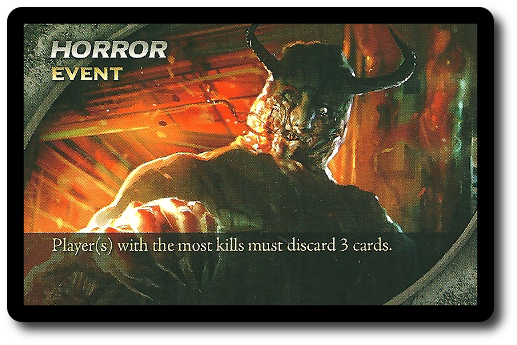
Retreat Card
This single card is placed at the bottom of the Event deck. If the Retreat card is revealed (all the Event cards are drawn), the game ends.

Action Cards
Action cards allow the player to trigger specific and special abilities when played. Action cards must be purchased and will later come into play when their owner draws them into their hand.
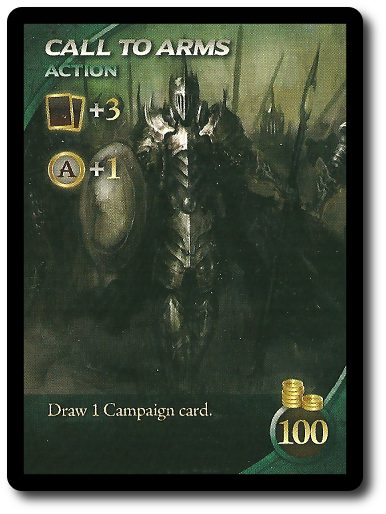
Invader Cards
These cards represent the many monsters and horrors that make up the Draconis army. Blue Invaders are less powerful than Gold Invaders. Each Invader has a Health Value (how much damage they can take before defeated), Glory Points (victory points awarded at the end of the game), a Class (used to determine the outcome of some cards), and a Reveal Effect that is immediately resolved when the Invader is brought into play.
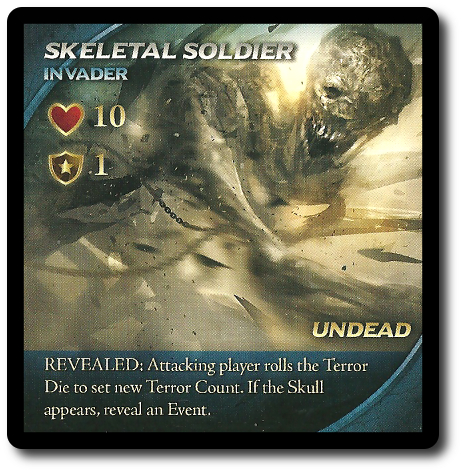
Defender Cards
These cards represent the army of brave warriors that the players control to defend against the Draconis army. Defender cards have an Attack Damage value that is used to determine how much damage they inflict on Invader cards, the Cost (in gold) that must be paid before they will risk their lives in a fight, and a Defender Effect that is resolved when the card is played.

Campaign Cards
These are special missions, side-quests of a sort, that can be completed during the game to provide bonus Glory Points. Campaigns are optional to pursue but are a great source of victory points making them essential for those players who want to win the game.
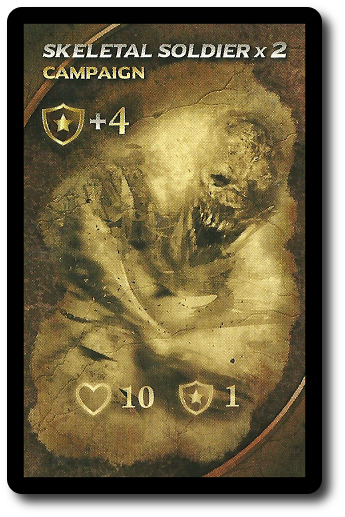
Something Wicked (With Lots of Teeth) This Way Comes
Draconis: Invasion is played in turns with no set number of turns per game. On a player’s turn, they will complete one default action and then select one of three possible choice actions. The actions are summarized here, but before they take any action, they must first resolve the effects of any Event cards they currently possess.
Default Action: Take an Action
A player can play one Action card from their hand, resolving its effects as soon as it’s played. Some Action cards will allow for additional cards to be played. Action cards remain in play for the duration of the player’s turn. It should also be noted that some Action cards can be used during an opponent’s turn.
Optional Choice Action: Buy a Card
A player may use their Gold cards to “buy” a Gold, Action, or Defender card that is currently face-up on the table. The Gold cards are played face-up and their total value is determined. The purchased card must be equal to or less than the total amount of gold provided. Purchased cards are immediately placed face-up in the player’s discard pile. Some Action cards may allow the player to purchase more than one card per turn.
Optional Choice Action: Start a Campaign
A player may draw a total of 2 Campaign cards, either taking them from the Campaign draw deck or selecting a face-up Campaign card. These newly acquired Campaign cards are added to the player’s already owned Campaign cards, remaining face-down and secret.
Optional Choice Action: Defeat an Invader
A player may attempt to defeat one face-up Invader card. To do so, the player plays any number of Defender cards they have in their hand, but only if they can also pay for them using their gold cards. The player then determines the total Attack value. If the Attack value is higher than or equal to the Invader’s Health Points, the attack succeeded. In all cases, any effects and special abilities on the cards are resolved. Defeated Invaders are collected and placed face-down and kept in their own pile in front of the player. The Invader row is then given a new card, resolving any effects that are triggered when the Invader is revealed. It’s also possible for an opponent to have cards that are triggered when an Invader is attacked. These must be resolved at the time they are revealed.
Ending the Turn
The player ends their turn by discarding all cards left in their hand and in play in front of them. The player then draws 6 new cards from their draw deck. If the player’s draw deck is depleted, they take their discard pile, shuffle it, and place if face-down to form their new draw deck. They then draw enough cards to bring their hand size to a total of 6 cards. The next player now takes their turn.
The Cold Hand of Terror
Terror cards will be added to the player’s discard pile and will populate the player’s hand. If the Terror card is discarded during the player’s turn, the terror level increases by +1 for each Terror card discarded. The Terror die value is then increased as needed. The Terror die value is matched to the Terror Die card and the effect is resolved. Whenever the Terror die reaches “6”, an Event card is drawn and immediately given to the next player in the turn order sequence. When it’s this player’s turn, they will reveal the Terror card and resolve it.
Ending the Game and Victory
The game immediately ends if a player collects six or more defeated Invader cards or the last Event card is drawn (revealing the Retreat card). Each player counts their total number of Glory Points, taking into account any completed Campaign cards. The player with the most Glory Points (victory points) wins the game! If there is a tie, victory goes to the player with the most gold.
Game Variants
Draconis: Invasion can be played as a solitaire game if a player wants to go about attempting to defeat the forces of evil alone. There is also a 2-player variant and the ability to play the game on a team with another player, adding a cooperative element.
To learn more about Draconis: Invasion, visit the game’s website.
Final Word
 The Child Geeks had no problem learning how to play the game as most of them were already familiar with other deck-building games. Draconis: Invasion does not introduce a lot of new rules or ideas when it comes to the deck-building genre, making much of the game play instantly recognizable. What threw our Child Geeks off was the constant need to pay for their army. According to one Child Geek, “I don’t like that I have to keep paying for my warriors. Why can’t I just pay for them once and use them whenever I want?” Because that’s not how the game is played, that’s why. Draconis: Invasion challenges the players to build their army and then demands that they have the funds necessary to fuel their war machine. This really bugged some of our Child Geeks and was barely mentioned by others. As one Child Geek put it, “I think it makes total sense that I have to pay my army. Why would they fight and risk their lives for free?” Good point. When Draconis was finally defeated, the Child Geeks gave the game a mixed level of approval.
The Child Geeks had no problem learning how to play the game as most of them were already familiar with other deck-building games. Draconis: Invasion does not introduce a lot of new rules or ideas when it comes to the deck-building genre, making much of the game play instantly recognizable. What threw our Child Geeks off was the constant need to pay for their army. According to one Child Geek, “I don’t like that I have to keep paying for my warriors. Why can’t I just pay for them once and use them whenever I want?” Because that’s not how the game is played, that’s why. Draconis: Invasion challenges the players to build their army and then demands that they have the funds necessary to fuel their war machine. This really bugged some of our Child Geeks and was barely mentioned by others. As one Child Geek put it, “I think it makes total sense that I have to pay my army. Why would they fight and risk their lives for free?” Good point. When Draconis was finally defeated, the Child Geeks gave the game a mixed level of approval.
 The Parent Geeks had many of the same concerns and response as the Child Geeks. Turns out that the fastest way to bug a deck-building player is to introduce rules that fill their deck with cards they cannot or do not want to play. Case in point, the Terror cards. According to one Parent Geek, “I like the concept, but not the execution. Filling my hand with Terror cards sucks. Penalizing me for doing exactly what I should be doing – building a finely tuned deck – is downright stupid.” Another Parent Geek said, “While I do not particularly like the idea of my deck filled with cards that I do not want, I do like how it works thematically in the game. I like the idea that the game gets harder the longer the invasion occurs. It forces me to think hard about each of my moves.” When the last army of Draconis was defeated, the Parent Geeks gave the game a mixed level of approval.
The Parent Geeks had many of the same concerns and response as the Child Geeks. Turns out that the fastest way to bug a deck-building player is to introduce rules that fill their deck with cards they cannot or do not want to play. Case in point, the Terror cards. According to one Parent Geek, “I like the concept, but not the execution. Filling my hand with Terror cards sucks. Penalizing me for doing exactly what I should be doing – building a finely tuned deck – is downright stupid.” Another Parent Geek said, “While I do not particularly like the idea of my deck filled with cards that I do not want, I do like how it works thematically in the game. I like the idea that the game gets harder the longer the invasion occurs. It forces me to think hard about each of my moves.” When the last army of Draconis was defeated, the Parent Geeks gave the game a mixed level of approval.
 The Gamer Geeks either loved the game or hated it with a passion. Those Gamer Geeks who disliked the game commented continually about how the game felt unimaginative (no new rules, making the game feel fairly standard and boring), poorly designed (not fans of the Terror cards or the fact that you have to keep paying for your army), or how it took forever to move the game forward to a point where you were actually fighting a battle (the lack of being able to purchase high enough leveled Defenders and matching them to the right Invaders). But, oddly enough, these same points were seen as positives by those who did enjoy the game. The Gamer Geeks who liked it found that the game’s mechanics, while not inventive, were nevertheless solid. They also liked the challenge of buying their army that they would then have to pay for, making the army building aspect much more than simply buying power. They also liked how the Terror cards moved the game along, while at the same time added to the game’s overall thematic feeling and difficulty. When all was said and done, Draconis: Invasion left the Gamer Geeks split, with half praising its glory and the other half cursing it.
The Gamer Geeks either loved the game or hated it with a passion. Those Gamer Geeks who disliked the game commented continually about how the game felt unimaginative (no new rules, making the game feel fairly standard and boring), poorly designed (not fans of the Terror cards or the fact that you have to keep paying for your army), or how it took forever to move the game forward to a point where you were actually fighting a battle (the lack of being able to purchase high enough leveled Defenders and matching them to the right Invaders). But, oddly enough, these same points were seen as positives by those who did enjoy the game. The Gamer Geeks who liked it found that the game’s mechanics, while not inventive, were nevertheless solid. They also liked the challenge of buying their army that they would then have to pay for, making the army building aspect much more than simply buying power. They also liked how the Terror cards moved the game along, while at the same time added to the game’s overall thematic feeling and difficulty. When all was said and done, Draconis: Invasion left the Gamer Geeks split, with half praising its glory and the other half cursing it.
 Draconis: Invasion will not be blowing the minds of any player who is already familiar with deck-building games. It is, in many ways, a derivative of other popular deck-building games, such as Dominion. But don’t let that stop you from giving the game a try. While many of its mechanics and rules will be familiar to experience players, the game has a distinct feel of its own.
Draconis: Invasion will not be blowing the minds of any player who is already familiar with deck-building games. It is, in many ways, a derivative of other popular deck-building games, such as Dominion. But don’t let that stop you from giving the game a try. While many of its mechanics and rules will be familiar to experience players, the game has a distinct feel of its own.
The game punishes players a lot. It was mentioned a number of times by our playing groups how much they disliked the fact that Terror cards kept worming their way into their decks. Thematically, this makes total sense when you consider that the player is attempting to raise an army against a seemingly insurmountable threat. Game-wise, it means that the player is being given junk that they do not want and must suffer additional consequences if they want to get rid of it. It’s a one-two punch that left a number of our players hurting. It’s difficult to get rid of cards in the game, making the deck-building process an exercise in compromise. No player will have the “ultimate deck”, but a player can create a deck that does more good than harm. Players crawl across the finish line in this game. They never sprint.
Another aspect of the game that had our play groups scratching their head in both bewilderment and frustration is the need to constantly “buy” your cards well after you purchased them. The “pay to play” model is alive and well in Draconis: Invasion, forcing players to carefully consider each turn if they want to invest in new cards or invest in their army. While this rule appeared at first as an interesting challenge, most of our players found that their army was fairly useless because they didn’t have the cards in hand to bring them into play. There is a need, you see, to balance both wealth and power in the game. If the player ignores this and does not design their “machine” (their deck of cards) to produce both an army and the wealth to use it, the player will never be able to defeat a single invader.
While the game is easy enough to teach and to learn, it’s not easy to win. I really liked this as it stopped me from approaching it with my typical “deck-building strategy” and I had to completely rethink my tactics. I normally build my decks by purchasing cards that I know were going provide the next stage of my “master plan”. You cannot do that in Draconis: Invasion. Instead, you must consider at all times the cost of playing. Purchasing cards is not enough. You must be able to continually fuel your fires if you ever expect to generate enough heat to claim victory.
The negative result of this is, however, not much happens for a bit. Players will focus first and foremost on collecting gold and then purchasing the right Defenders to outmatch the visible Invaders. All the while, the Terror cards continue to slip into a player’s deck of cards, making it all the more difficult to correctly stack the deck with the right number and type of cards. The smart player will focus on their Campaigns by targeting specific Invaders to score lots of points, making the process of determining which Invaders to focus on a simple task. It doesn’t make for a lot of rememberable moments, but it certainly does challenge you to stay the course and keep your eyes steadily on the prize.
Draconis: Invasion is a game that our players either loved or loathed. It was interesting to see how the game challenged our players to rethink what they thought was necessary to win a deck-building game. Some of the rules are bit wonky, but nothing that a quick dive into the cards and a few games under the belt won’t clarify. For those players who have found their deck-building game of choice, they may find Draconis: Invasion to be an unwelcomed addition to the gaming table since it changes the script enough to make the game feel a bit out-of-place. For those who have not played many deck-building games or are looking to challenge their own abilities, then Draconis: Invasion should be a good time.
This game was given to Father Geek as a review copy. Father Geek was not paid, bribed, wined, dined, or threatened in vain hopes of influencing this review. Such is the statuesque and legendary integrity of Father Geek.



